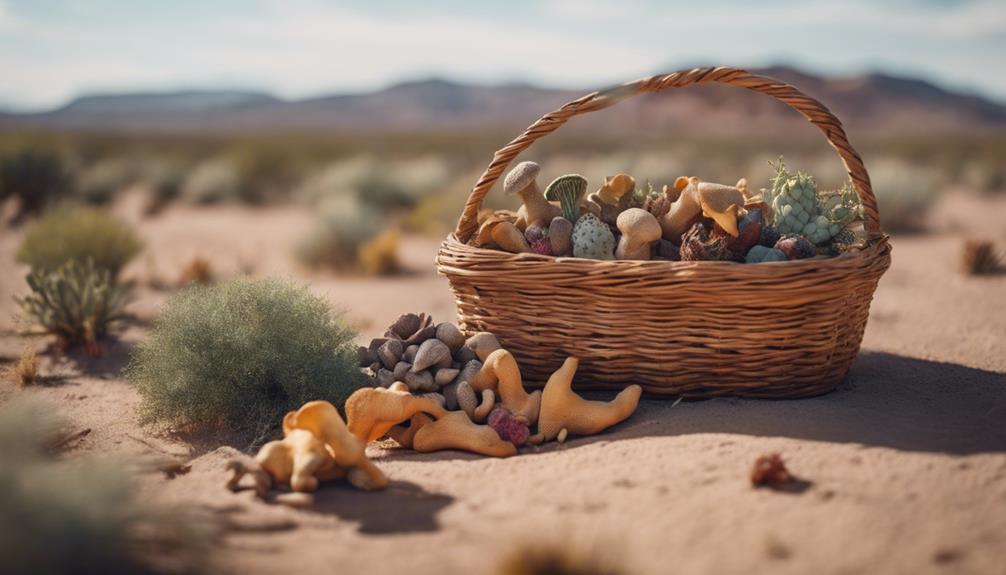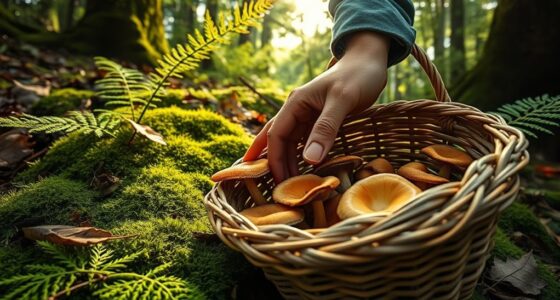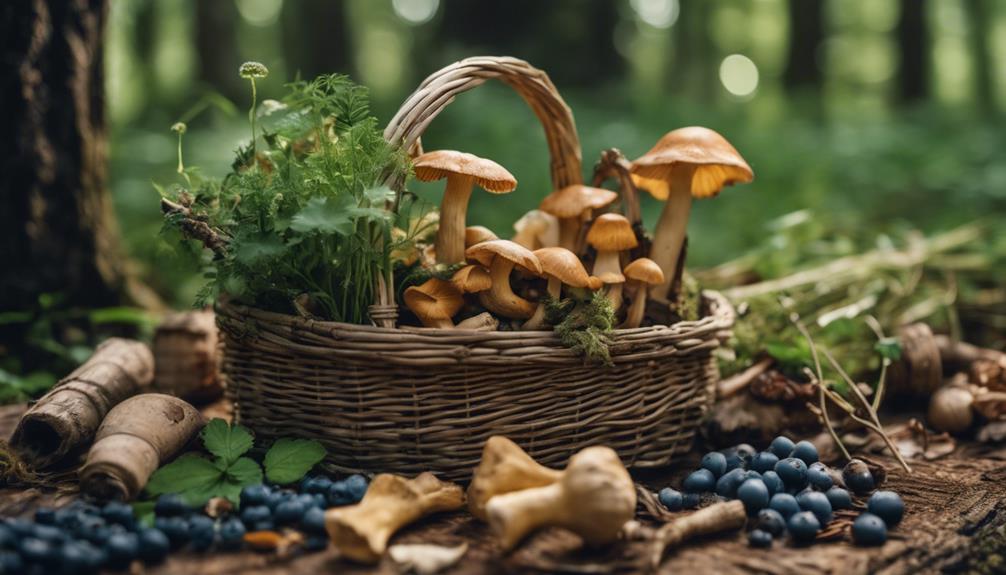As you venture into New Mexico's desert landscape, you'll discover a culinary treasure trove of native edible plants. From prickly pear cactus pads to Cholla buds and Pigweed, these unique flavors await your discovery. Understanding the geographical distribution and climate is essential for foraging, as it shapes the plant life and influences the types of wild edibles you'll find. With a blend of cultural significance, historical uses, and sustainable harvesting practices, you're about to uncover the secrets of foraging in the desert. And, as you explore further, you'll uncover even more surprises hidden in New Mexico's edible wilds.
Key Takeaways
- Identify native edible plants like Prickly Pear cactus pads, Cholla buds, and Pigweed to ensure safe and sustainable foraging in New Mexico's arid landscape.
- Understand the geographical distribution of wild edibles in New Mexico's diverse landscapes, including the Chihuahuan Desert, to locate and harvest plants responsibly.
- Respect cultural significance and historical uses of native plants, like Yucca and Blue Corn, by understanding their cultural heritage and traditional practices.
- Practice sustainable harvesting by taking only what is needed, avoiding sensitive habitats, and monitoring ecosystems to ensure long-term sustainability.
- Prioritize foraging safety by identifying plants correctly, avoiding poisonous look-alikes, and obtaining necessary permissions to prevent adverse consequences.
Native Edible Plants of New Mexico
When foraging in New Mexico, you'll find a variety of native edible plants that have been used for centuries by Indigenous peoples and early settlers to supplement their diets.
One of the most iconic plants you'll come across is the prickly pear cactus, whose pads can be eaten raw or cooked.
Another notable edible part is the cholla buds, harvested from the Cholla cactus, which can be pickled or sautéed.
You might also stumble upon Pigweed, a diverse edible plant species well-adapted to arid conditions in New Mexico.
Buffalo Gourd seeds, traditionally used by Indigenous peoples as a food source, can also be found in the region.
If you're looking for a vitamin C boost, Wild Rose hips are commonly used to make tea or syrup.
And in times of need, Willow inner bark was historically consumed as emergency food by Indigenous peoples in New Mexico.
These plants have been a staple in the region for centuries, and with the right knowledge, you can enjoy them too.
Geographical Distribution and Climate

Exploring New Mexico's diverse landscapes, you'll discover that the state's unique geography and climate play a significant role in shaping the variety of wild edibles available for foraging.
From desert plains to high mountains, the state's varied terrain offers a wide range of foraging opportunities. The semi-arid to arid climate, with hot summers and cold winters, influences the types of plants that thrive in each region.
Different regions, such as the Chihuahuan Desert and the Sangre de Cristo Mountains, offer unique wild edibles based on their climate and terrain. The desert ecosystem is home to resilient native species like prickly pear cactus, mesquite, and yucca, which have adapted to thrive in arid conditions.
When foraging in New Mexico, being attuned to the specific plant species that can survive and flourish in the state's desert environment is crucial. By understanding the geographical distribution and climate, you'll increase your chances of successful foraging experiences and discover the rich variety of wild edibles that New Mexico has to offer.
Historical Significance and Uses

Delving into New Mexico's rich cultural heritage, you'll uncover the profound historical significance of native edibles, which have been woven into the fabric of Indigenous and Spanish colonial traditions.
Native edibles, such as Yucca, Blue Corn, and Cholla Cactus, have been essential for food, medicinal purposes, and traditional practices for centuries. Indigenous tribes like the Navajo and Pueblo peoples have long utilized native plants for sustenance and healing, often relying on herbal medicine to treat ailments.
The culinary techniques and uses of native plants in New Mexico showcase a blend of Indigenous and European practices, reflecting the region's unique cultural fusion.
Understanding the historical significance of New Mexico's native edibles enriches appreciation for the land's cultural heritage.
As you explore the desert landscape, you'll gain a deeper respect for the Native American communities that have thrived here for generations, and the traditional uses of these plants that have been passed down through generations.
Identifying and Harvesting Edibles

Your foraging adventure in New Mexico begins with identifying the diverse array of wild edibles that thrive in the desert landscape. As you explore the desert, you'll encounter an array of plants with unique flavors and nutritional benefits, from pigweed and buffalo gourd to thistle and wild onion. To guarantee a successful foraging experience, it's crucial to properly identify the plants you come across.
Here are some key considerations to keep in mind:
- Proper identification: Make sure you can accurately identify the plants you plan to harvest, as some can be toxic or cause allergic reactions.
- Respect for land regulations: Familiarize yourself with local regulations and private property boundaries to avoid trespassing or over-harvesting.
- Sustainable harvesting practices: Harvest plants in a way that ensures their continued growth and minimizes environmental impact.
- Respect for cultural significance: Be mindful of plants with cultural or historical significance, and harvest them in a way that respects their importance.
Culinary Uses and Recipes

Now that you've learned to identify and harvest edible desert plants, it's time to get creative in the kitchen! You'll discover that these wild ingredients can be used in a variety of dishes, from sweet treats to savory meals.
Let's explore some Desert Delights Recipes that showcase the unique flavors and textures of these wild edibles in your kitchen.
Desert Delights Recipes
As you venture into the world of desert foraging, you'll discover a treasure trove of unique flavors and textures to incorporate into your culinary creations. The desert landscape offers a diverse array of edible plants, each with its own distinct characteristics and uses.
Here are some ideas to get you started:
- Mesquite Magic: Dry and powder mesquite beans to add a sweet, nutty flavor to baked goods and savory dishes.
- Prickly Pear Delight: Steam prickly pear cactus pads and serve with a squeeze of lime juice and a sprinkle of salt.
- Palo Verde Pulse: Experiment with roasting Palo Verde beans to bring out their rich, earthy flavor.
- Jojoba Crunch: Toast jojoba seeds to add a satisfying crunch to salads and snacks.
As you experiment with these desert delights, remember to take into account the quality of your foraged ingredients, their flavor profiles, and presentation techniques to create visually appealing and harmonious dishes. With a little creativity, you'll be well on your way to crafting unique and delicious meals that showcase the flavors of the desert.
Wild Edibles in Kitchen
With your newfound knowledge of desert delights, start incorporating these wild edibles into your culinary creations, and you'll soon discover the unique flavors and textures they bring to your kitchen. As you experiment with foraging in the desert, you'll find that these wild edibles can elevate your cooking to a whole new level.
Try using prickly pear cactus pads in salads, stews, or as a grilled vegetable for a distinctive Southwestern flavor. Mesquite bean flour adds a nutty, sweet flavor to baked goods like bread, muffins, or pancakes. Cholla buds can be pickled, stir-fried, or boiled to remove spines and enhance their flavor. Jojoba seeds can be infused into oils for skincare products or ground into a gluten-free flour alternative for baking.
Take your desert-inspired cooking to the next level by creating a invigorating prickly pear lemonade. Blend prickly pear fruit with water, lemon juice, and a sweetener of choice for a taste of the desert.
Medicinal Benefits and Remedies

You'll find that foraging in the desert yields a treasure trove of medicinal benefits and remedies, thanks to the abundance of plants like Oshá and Cebastien RoseChaparral. New Mexico's rich cultural heritage, influenced by Native American and Hispanic traditions, has contributed to the popularity of herbal medicine in the region.
Here are just a few examples of the medicinal benefits you can find in New Mexico's wild edibles:
- Antibiotic and antimicrobial effects: Oshá, also known as Indian parsley, is renowned for its ability to strengthen the immune system and combat infections.
- Perineum care and relaxation: Cebastien RoseChaparral is used in sitz baths to reduce inflammation, promote healing, and provide relaxation.
- Aromatherapy and cold prevention: Foraged products like Cebastien RoseChaparral and Oshá are used to prevent colds, flu, and respiratory issues, and can even be used in aromatherapy.
- Traditional herbal practices: New Mexico's Native Edible Plants have been used for centuries by Indigenous peoples, offering a rich source of medicinal benefits that continue to inspire modern herbal practices.
Propagation and Cultivation Tips

When propagating native New Mexican plants, select seeds suited to arid climates to guarantee successful cultivation.
You'll want to start seeds indoors to make sure robust plant growth before transplanting them outdoors. This step is essential, as it allows the seeds to develop strong roots and stems, making them more resilient to the harsh desert environment.
When it's time to transplant, follow infrequent but deep irrigation schedules to mimic natural conditions and promote plant health. This approach will help your native plants thrive in the arid climate.
Properly identifying native plants for cultivation is vital to maintain the authenticity of the species. By doing so, you'll be supporting biodiversity and sustainable gardening practices in arid environments.
Sustainable Harvesting Practices

Dr. Tomas Enos emphasizes that adopting sustainable harvesting practices is essential to maintaining plant populations in the desert. As a forager, you're responsible for guaranteeing the long-term survival of these species. By understanding the delicate balance of native plants in New Mexico, you can secure their continued thrival for generations to come.
Here are some key sustainable harvesting practices to keep in mind:
- Harvest only what you need: Avoid over-harvesting, as this can deplete plant populations and disrupt the ecosystem.
- Identify plants correctly: Make sure you're harvesting the correct species to avoid contaminating the ecosystem with invasive species.
- Avoid sensitive habitats: Refrain from harvesting in sensitive habitats, such as endangered species' habitats or areas with fragile ecosystems.
- Monitor and adapt: Continuously monitor the ecosystem and adapt your harvesting practices accordingly to secure the long-term sustainability of native plants.
Popular Native Edible Plants

As you explore the desert landscape, you'll discover a variety of native edible plants that have been used for centuries. From Pigweed to Cholla buds, these desert delicacies offer a taste of the region's rich cultural heritage.
You'll learn about the unique characteristics and uses of these wild edibles, and how they can add flavor and nutrition to your meals. Foraging in Colorado offers a diverse array of edible plants, from wild berries to medicinal herbs, all thriving in the state’s varied landscapes. By incorporating these ingredients into your cooking, you not only enhance your dishes with earthy and fresh flavors but also benefit from the high nutritional content found in nature. Whether you’re hiking through mountain trails or exploring local forests, foraging in Colorado provides an opportunity to connect with nature while sourcing sustainable food.
Desert Delicacies Found
In the arid landscape of New Mexico, you can uncover a treasure trove of native edible plants, each with its unique flavor profile and nutritional benefits. As you venture into the desert, you'll discover a diverse range of plants that have been used by Indigenous tribes like the Navajo and Pueblo peoples for centuries.
Some of the most prized desert delicacies include:
- Wild onions, used in soups and stews for their pungent flavor.
- Thistles, whose young leaves and stems make a tasty addition to salads.
- Wild roses, whose hips are rich in vitamin C and can be used to make tea or syrup.
- Watercress, a peppery green perfect for adding crunch to sandwiches or salads.
These plants offer a blend of flavors, culinary uses, and nutritional benefits that reflect the rich cultural heritage of New Mexico.
Whether you're a seasoned forager or just starting out, the desert landscape holds a wealth of edible treasures waiting to be discovered. By embracing the art of foraging, you can reconnect with the land, preserve traditional practices, and savor the unique flavors of the desert.
Wild Edibles of Old
Beyond the desert delicacies you've already discovered, you'll find an array of wild edibles that have been staples in Native American cuisine for centuries, from pigweed to buffalo gourd seeds. These native plants have been used for centuries, providing sustenance and nutrition to indigenous communities.
Pigweed, a diverse and adaptable species, thrives in New Mexico's arid conditions. Its leaves, stems, and seeds are all edible, making it a valuable resource. Buffalo gourd seeds, rich in protein and oil, were traditionally used as a food source. Cholla buds, harvested from the Cholla cactus, offer a unique and edible part of the plant.
Wild rose hips, high in vitamin C, are commonly used to make tea or syrup. Cottonwood inner bark, historically used as emergency food, showcases the diverse edible plants found in New Mexico. By foraging for these wild edibles, you'll not only discover new flavors but also connect with the rich cultural heritage of New Mexico's native communities.
Foraging Safety and Precautions

You must take specific precautions when foraging in the desert to guarantee a safe and successful harvest. Foraging safety should always be your top priority, as misidentifying a plant or ignoring potential hazards can have serious consequences.
Here are some essential precautions to keep in mind:
- Positive plant identification: Always positively identify plants before foraging to avoid poisonous look-alikes. Carry a field guide or use a foraging app to aid in plant identification.
- Permission and regulations: Obtain permission to forage on private land and respect local regulations in public areas.
- Avoid contaminated areas: Avoid foraging near roadsides or areas with potential contamination from pesticides or pollutants.
- Sustainable harvesting: Practice sustainable harvesting by only taking what you need and leaving enough for plant regeneration.
Frequently Asked Questions
Can You Forage in the Desert?
You can forage in the desert, but it's essential you're prepared and knowledgeable about the unique challenges and opportunities it presents, like understanding seasonality, identifying plants correctly, and practicing sustainable harvesting.
How Do You Forage Wild Edibles?
You identify and gather wild edibles like prickly pear cactus and mesquite pods, considering seasonality and readiness, while ensuring safety during hot weather, and then process them to enhance flavors and textures.
What to Forage in New Mexico?
You're in luck! In New Mexico, you can forage for prickly pear pads, which make a delicious and nutritious salad topping. Look for them in arid regions, and be sure to identify correctly to avoid mistaking them for similar-looking plants.
Where Not to Forage?
You shouldn't forage in contaminated areas like industrial sites, roadsides, or pesticide-sprayed zones. Avoid national parks, wildlife preserves, and private property without permission, as well as endangered species and polluted urban areas.
Conclusion
You've made it through the desert foraging crash course! Pat yourself on the back, congratulations are in order!
You're now equipped to venture into New Mexico's wilds, forage like a pro, and impress friends with your culinary creations.
Just remember, don't be that person who mistakes a poisonous lookalike for a tasty treat – stay vigilant, stay safe, and happy foraging!










